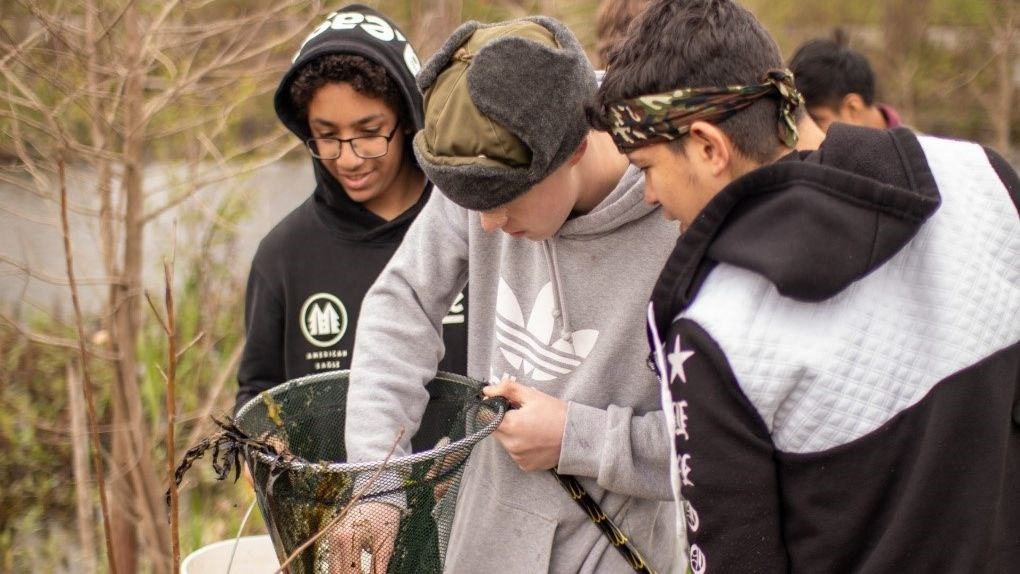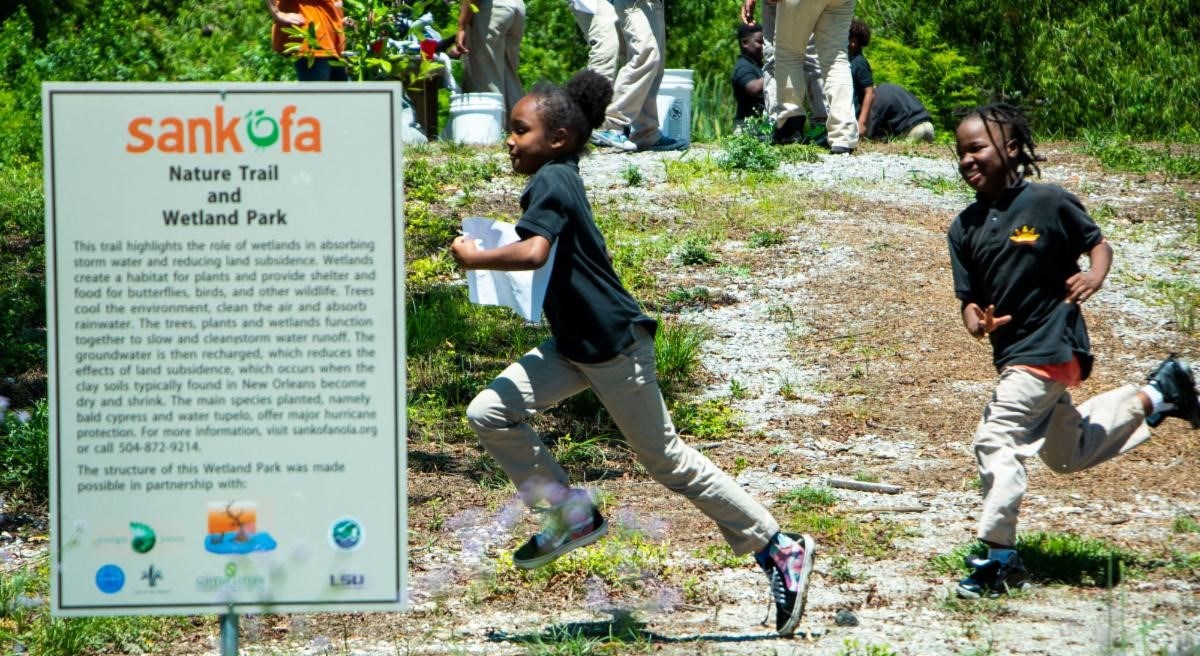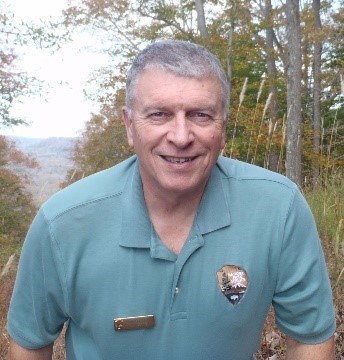Last updated: January 22, 2025
Article
After the Flood: Building Community Resiliency in New Orleans

Photo courtesy of Sankofa CDC.
By Suzanne Brinkley
In 2005, the Lower 9th Ward, a neighborhood in New Orleans, Louisiana, was devastated by Hurricane Katrina, one of the worst storms in U.S. history. The storm’s surge, along with an antiquated flood protection system, disabled stormwater pump stations meant to pump away large volumes of water. The impact caused more than 50 levee breaches which left 80% of the city submerged under water.
Today, less than 5,000, of its original 14,000 residents, remain in the Lower 9th Ward, a predominantly African American community. Blighted properties, overgrown lots and vacant buildings are scattered throughout the area which continues to be impacted by seasonal flooding.
As part of a larger neighborhood revitalization effort, a local nonprofit organization, the Sankofa Community Development Corporation (Sankofa CDC), collaborated with the National Park Service – Rivers, Trails and Conservation Assistance program, the City of New Orleans, and the Sewerage and Water Board of New Orleans in developing plans for the Sankofa Wetland Park and Nature Trail – a community-driven recovery project to improve protection from hurricanes and flooding in the neighborhood.
The project began in 2017 on a vacant 40-acre site which has since then been transformed into a valued conservation and recreational area that integrates nature-based climate resiliency solutions to improve protection against future natural disasters.
“One of the underlying hopes of this project is that it will help increase investment in the area by getting homes rebuilt and people back into the neighborhood,” said Russell Clark, a National Park Service landscape architect who assisted in translating the community’s vision into a park design concept. “Having an amenity like this, in an area where there aren’t many, especially to this scale, will be a huge attraction.”
In partnership with Sankofa CDC, Clark, along with two of his colleagues, facilitated a master plan and design process which included extensive community outreach efforts to build project support among residents and neighborhood organizations.

Developed by the National Park Service.
After learning about the community’s vision for the park, the National Park Service developed a master plan for the unique site which incorporates a 10-acre wetland pond that will function as a stormwater filtration and absorption system while providing recreation opportunities such as fishing, canoeing and kayaking. Other elements of the plan include nature trails, picnic areas, interpretive signage, outdoor recreation facilities, and a bicycle trail system that will connect the Lower 9th Ward to adjoining neighborhoods.
“We don’t do anything without having a lot of community input,” said Tricia LeBlanc, Director for the Sankofa Wetland Park and Nature Trail. “We need to make sure we are truly serving them by ensuring they are a part of the conversations.”
Through grants and volunteer support, 8 acres of habitat have been restored. Additionally, invasive plants were removed and replaced with native trees and flora that absorb rainwater, slow and clean stormwater runoff, and reduce the area’s extreme heat temperatures. Future plans include developing an on-site plant nursery that will grow regional wetland trees and shrubs and engage community members in gardening activities.

Photo courtesy of Sankofa CDC.
The New Orleans Chapter of Engineers Without Borders, a nonprofit organization that provides communities with pro-bono engineering services, collaborated with Sankofa CDC in developing bioretention ponds for the wetlands. Once completed, the wetlands will retain 8 million gallons of stormwater and reduce land subsidence – the gradual settling or sudden sinking of the ground. The organization also helped ensure that the park and its facilities are accessible to everyone within the community by following design guidelines set by the Americans with Disabilities Act.
“It’s been a fantastic partnership,” Clark said. “Rashida Ferdinand [the Executive Director for Sankofa CDC] has been a great leader for the organization. They have dug in deeply in terms of getting the community behind this process and have reached out to all levels of city and state agencies to get them involved in this effort as well. They have been diligent on grant funding to implement this vision. It’s exciting to see how far they’ve come in just the few years I’ve been involved.”
Sankofa Wetland Park and Nature Trail will not only help reduce the impact of flooding but will also teach children how to become stewards of their environment. With support from local schools, Sankofa CDC has leveraged park resources in developing an environmental stewardship program which incorporates STEM education and introduces children to wetland conservation through activities such as water quality testing, flora and fauna species identification, removal of invasive vegetation and planting of native trees.

Photo courtesy of Sankofa CDC.
Once the proposed Sankofa CDC Workforce Development Program is launched, the park and nature trail will also serve as a classroom for adults. Capitalizing on the park as an outdoor classroom, the program will provide residents with valuable hands-on job training and education in topics related to horticulture and green infrastructure such as stormwater systems, rain gardens and more. The three-month paid training program will help participants prepare for the state licensing exam as a pathway to a career in landscaping and horticulture.
Sankofa CDC will continue to work on the park and nature trail in the coming months and anticipate that it will be completed by the end of 2022. Remaining work includes integrating the engineered overflow water system into the existing underground stormwater pipe system, completing park facilities and developing a park maintenance plan.
“As a resident of the Lower 9th Ward, I am thankful for the work Sankofa [CDC] has completed in the transformation of area of neglect into an area of beauty,” said Dawn Davis, a Lower 9th Ward resident. “I am excited about the positive impact it will have on our community.”

Photo courtesy of Sankofa CDC.
A cooperative agreement between the City of New Orleans and Sankofa CDC has been negotiated in which the two entities will be engaged in a 20-year partnership and Sankofa CDC will be responsible for the completion and maintenance of the park. Sankofa CDC hired a landscape architect and horticulturalist with a background in park management to interpret and implement the master plan that the National Park Service developed.
Sankofa Wetland Park and Nature Trail has already helped mitigate flooding effects from natural disasters as seen during Hurricane Ida when the wetlands absorbed stormwater runoff. Proving, that in addition to providing outdoor recreation and education opportunities, the wetland park is helping the community become resilient to a changing climate.
“It’s an opportunity to help heal after a devastating event and have a focal point within the neighborhood to bring the community together,” LeBlanc said. “There’s no other major park like Sankofa Wetland Park and Nature Trail, that includes nature space in close proximity to this part of the city.”

Photo courtesy of Sankofa CDC

Project Lead: Russell L. Clark
Landscape Architect & Community Planner
Russ provides technical planning assistance to local communities to create greenway and blueway trails throughout Kentucky. The National Park Service – Rivers, Trails and Conservation Assistance Program allows Russ to pursue his passion for assisting organizations and communities to improve access to parks, recreation facilities and to conserve natural resources with a goal of making it easier for people to get outdoors and be active locally. Russ is based out of a field office at Mammoth Cave National Park.
